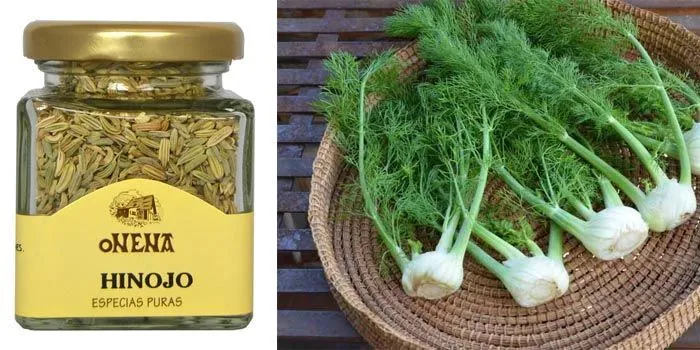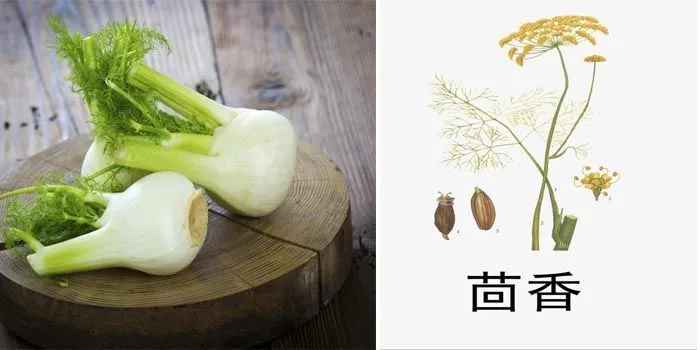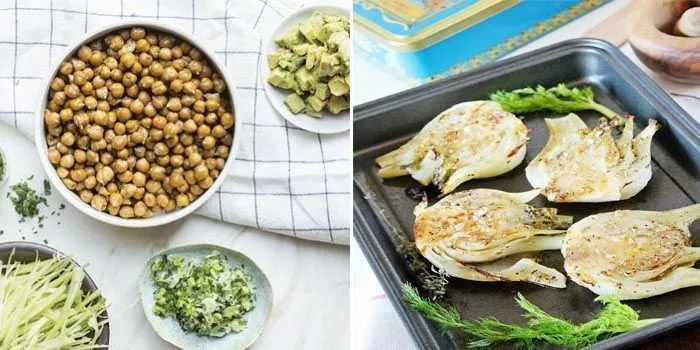Fennel is an aromatic plant known around the world but not so much used in gastronomy (perhaps for lack of ideas). Like many other plants that are grown considered aromatic, they have a large number of plant extracts that possess medicinal properties.
Therefore, we wanted to carry out a review of the main properties of fennel and ways to use it in the kitchen.
Table of Contents
What is fennel?
Fennel, scientifically known as Foeniculum vulgare, is considered a aromatic plant whose origin is dated in the Mediterranean basin. It is in this area where we can still see it grow spontaneously in the wild.
However, it has also been cultivated in other areas of Europe and, to this day, is not widespread or spread throughout the world.
To attract attention regarding the properties of fennel, tell you that this aromatic plant is used as a basis for preparing the famous alcoholic beverage absinthe.
Characteristics of the plant
The fennel plant is herbaceous (it is considered as a horticultural within the aromatic ones). Leaves of intense green color and very vertical growth, with an arrangement very similar to that of the celery or carrot plant.
After its productive period, it emits inflorescences (yellow flowering) that if allowed to develop, will form the future fruit that is also used as a condiment.
When the fennel plant is left for seeds, is usually used industrially to obtain the active ingredient anethole from whose extraction, flavored with licorice and anise, is used to prepare well-known liqueurs in the Mediterranean area.
Characteristics of the flower
In the Mediterranean area, fennel flowering occurs in early summer, late June and early July. At that time, the inflorescences begin to open and give the field very attractive yellow tones.
From July is when the formation of seeds begins, which also have a lot of interest for medicinal and industrial use (for their essential oils).
Known varieties
Wild fennel, the usual and most consumed in the kitchen, which predominates over the rest of the varieties.
Carmo– a type of fennel of smooth texture, quite rounded bulb and white color, similar to wild.
firm, smooth, white bulb with a rounded shape.
Fennel from Florence, a sweeter variety than others, typical of the spring months and that is increasingly spreading its cultivation to other countries, including Spanish.
Also known as “sweet”, it is beginning to be cultivated in the Spanish Levante, including the Region of Murcia. The most favorable months for the cultivation of this variety are those that comprise the spring season.
Pollux a variety in which the bulb predominates for its size and for its authentic rounded shape compared to other more oval varieties.
The story behind fennel properties

Greece and Italy, both European countries, were the largest fennel growers in history. In the XXI century, things have changed and we have countries like Russia, India, France or the United States that also do the same.
Fennel is typical of hot recipes for autumn and winter dishes. Basically stews that contain a lot of vegetables and often also some game meat.
What has most highlighted the properties of fennel has been for its nutritional composition, although today it has also been investigated for the effects of some of its phytocomponents.
Already in the time of Hippocrates, fennel was used for its medicinal qualities, since it favored the stimulation of the digestive system.
Nutritional composition
Let’s study the nutritional composition of fennel properties. A food that, as you will see, provides very few calories (more than 90% of the root is water) but can be interesting due to its aminogram and mineral content.
Caloric information per 100 grams
- Energy: 31 kcal
- Carbohydrates: 7.3 grams (2% RDA)
- Fat: 0,2 g
- Fiber: 3.1 g (12% RDA)
- ProteinAs: 1.2 g (2% RDA)
Amino acid concentration
| Composition | Concentration | % recommended daily |
|---|---|---|
| Vitamin A | 134 μg | 3% |
| Vitamin C | 12 mg | 20% |
| Niacin | 0.6 mg | 3% |
| Folate | 27 mg | 7% |
| Pantothenic acid | 0.2 mg | 2% |
Mineral concentration
- Calcium: 49 mg (5%)
- Iron: 0.7 mg (4%)
- Magnesium: 17 mg (4%)
- Phosphorus: 50 mg (5%)
- Potassium: 414 mg (12%)
- Zinc: 0.2 mg (1%)
- Copper: 0.1 mg (3%)
- Manganese: 0.2 mg (10%)
- Selenium: 0.7 mg (1%)
Uses of fennel in traditional medicine

One of the most exponent cultures in terms of the use of fennel properties was traditional Chinese medicine, which used this aromatic plant to treat various ailments and resources, such as increasing the volume of breast milk or relieving nasal congestion.
It was also used topically to reduce infection from insect bites.
Fennel seed oil phytocompounds
From fennel seeds you can produce an oil highly valued in cosmetics and for the preparation of different liquors (including absinthe). It contains 60% anethole, 15% fenchone and almost 5% estragole.
These compounds are also closely related to the properties of anise. In fact, some of them give it the characteristic aniseed smell.
Properties of fennel with scientific evidence
1. Rich source of vitamin C
One of the vitamin sources of which the properties of fennel stand out the most is for its content of vitamin C. It covers a high percentage of the recommended daily needs that we can complement with fruits of high content in this element.
In general, vitamin C improves the immune system, helps form collagen and is related to skin hydration. It has interesting antioxidant effects and contributes to reducing heart disease. [Study]
2. Relieves indigestion
Already in traditional Chinese medicine the properties of fennel are used to improve digestion in heavy meals and relieve stomach heaviness.
What is known today through various scientific trials is that it is claimed to facilitate digestive transit. [Study]
This is due to its phytocomponents that improve the production and secretion of gastric juices, reducing inflammation of the stomach and intestines.
A common practice in the Indian community is to use fennel to chew its fibrous parts by extracting the juice after heavy meals. In turn, it also improves breath.
3. Eliminate flatulence
Fennel has been used since its inception in traditional medicine as a potent antiflatulent. This is due to the carminative properties of aspartic acid.
In fact, extracts of this aromatic plant are used as an adjunct in medications to combat non-ulcerative dyspepsia in young children. [Study]
Therefore, we count on fennel to be effective also for gases.
4. Regulates blood pressure
A blood pressure regulating mineral is potassium, as it helps fight spikes in sodium increase and improves blood circulation.
Several scientific studies have shown how the Western population is far from consuming the recommended 4700 mg of potassium. In fact, less than 2% of the adult U.S. population does, and that’s where many of the country’s big food problems stem.
Therefore, fennel, due to its high potassium content (along with other foods), can help regulate blood pressure, act on the vasodilator activity of the body and improve blood circulation.
On the other hand, it is important to eat foods that contain a small concentration of nitrates, as its role as vasodilator and vasoprotector has been scientifically proven. [Study]
5. Anticancer potential
One of the biggest struggles of modern medicine is to find medicines or natural products that can help prevent or reduce the effects of different types of cancer.
Specifically, many studies focus on the phytocompounds of many vegetables, including that of the properties of fennel.
What this aromatic plant has to say against this disease is the study carried out with fennel seeds where the response of its flavonoids, alkaloids and phenols in the protection against chemical radiation and its harmful effects was evaluated. [Study]
6. Fennel properties reduce respiratory disorders
Based on the information collected from many traditional medical manuals, the role of fennel properties against respiratory diseases (congestion, bronchitis, chronic cough, etc.) has been studied.
Both the seeds and the fennel powder favor the reduction of accumulation of mucus, toxins and relieves the nostrils and throat. This helps to greatly reduce the chance of increasing the risk of infections.
Read more: information on the phytochemical composition of fennel.
Prepare fennel infusion
A healthy way to also take advantage of the properties of fennel is by infusion, where we will obtain the concentrate of all its active ingredients.
For its preparation, it is important to know the amount per liter of water. In this case, the recommended amount is 10 to 20 grams of bulb or root per liter of water.
To prepare the fennel infusion we follow the same procedure as for other medicinal herbs. Heat the water and when it is boiling, add the crushed fennel root. Let cool and strain.
We can add other more powerful medicinal herbs to mix the flavor, such as thyme, oregano or rosemary.
Healthy recipes with the properties of fennel

Finally, we have to know at a gastronomic level this great unknown that is fennel.
Use of fennel in cooking
As it is usually used in the Mediterranean diet, it is as a spice to improve the flavor of stews, stews with legumes and lentils. In addition, its use also favors the improvement of digestion in dishes that are usually heavy (high fat content).
On the other hand, it combines very well with dishes with fish, since its aniseed touch is very similar to that of dill, usually used to season salmon and other fish.
There are different types of salads where fennel is used in cooking. In this case, it is advisable to cut it into very thin strips and accompany it with a good vinaigrette dressing, as Waldorf salad is usually prepared.
The plant stems they can be used to roast and accompany them as a garnish with other vegetables, in the same way that asparagus is usually prepared.
The seeds, for example, with a very characteristic flavor of anise, can be used to make breads and pastries, since it is now very fashionable to use different seeds for the cover of bread (pumpkin, pipes, fennel, raisins, etc.).
It is known the preparation in many countries of northern Europe the baked fennel or grilled (as you can see in the photo above).
This recipe is prepared by splitting the bulb in two and adding spices to season and a stream of extra virgin olive oil, cooked for just 20 minutes. No more mysteries. It is usually accompanied in the oven or iron of the aerial part (the leaves) so that it penetrates even more the aromas inside the bulb.
Fennel capsules
In herbalists and specialized stores, we can also find fennel capsules.
They are indicated for people who suffer from continuous digestive disorders and as a remedy to recover the intestinal flora.
Fennel capsules carry pure extract of the bulb or root and a harmless vegetable coating whose chemical name is hydroxypropylmethylcellulose.
Possible contraindications of fennel
As for side effects and contraindications of fennel, only mild allergic processes (slight airway obstruction, rashes and skin inflammation) have been documented in people allergic to the properties of fennel.
In most cases, it is due to the presence of some of the flavonoids or antioxidants they contain, and which are closely linked to those that anise or dill may contain.
Possible contraindications are due to the presence of anethole and the agol, which in large doses act as neurotoxicants. Depending on the sensitivity of the patient, it can cause arrhythmias of a mild nature, seizures and different states of drowsiness.
Who should not take oil from this plant:
- Gastritis sufferers
- Those who suffer epileptic episodes
- Parkinson’s disease.
- People who suffer from irritable color syndrome.
Fennel and pregnancy
The infusion of this medicinal plant or its use in agriculture is allowed in low doses for pregnant women. It is even indicated for situations where it is necessary to incorporate a little more iron into the diet, in order to avoid anemia in pregnant women.
In any case, consult with the gynecologist to know the maximum dose to use and if there are more interesting medicinal alternatives.
Consumption in small amounts during the newborn’s lactation period is also considered safe.
Likewise, it is also not recommended to give oil from this plant to children under 12 years old.
How to distinguish fennel and dill
Fennel (Foeniculum vulgare) and dill (Anethum graveolens) are totally different plants, although they have a lot of resemblance and share several active ingredients, since they belong to the same family (Apiaceae).
Both are characteristic for their aroma and aniseed flavor. However, the big difference is that the gastronomic and medicinal interest of the first is the bulb, large and oval, and the dill has a much thinner stem and green, similar to an asparagus.
